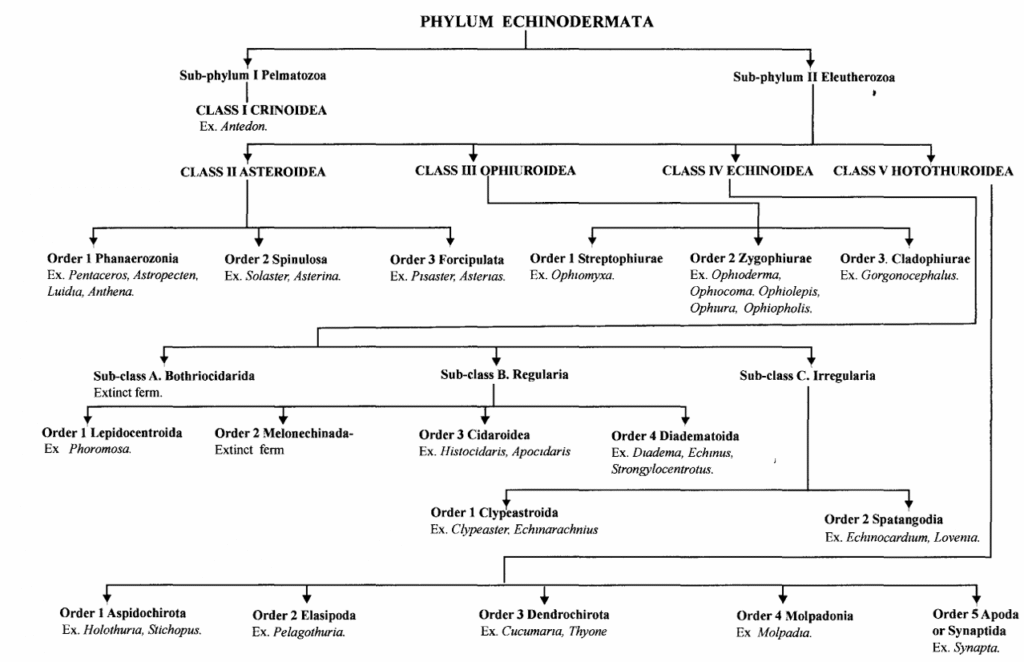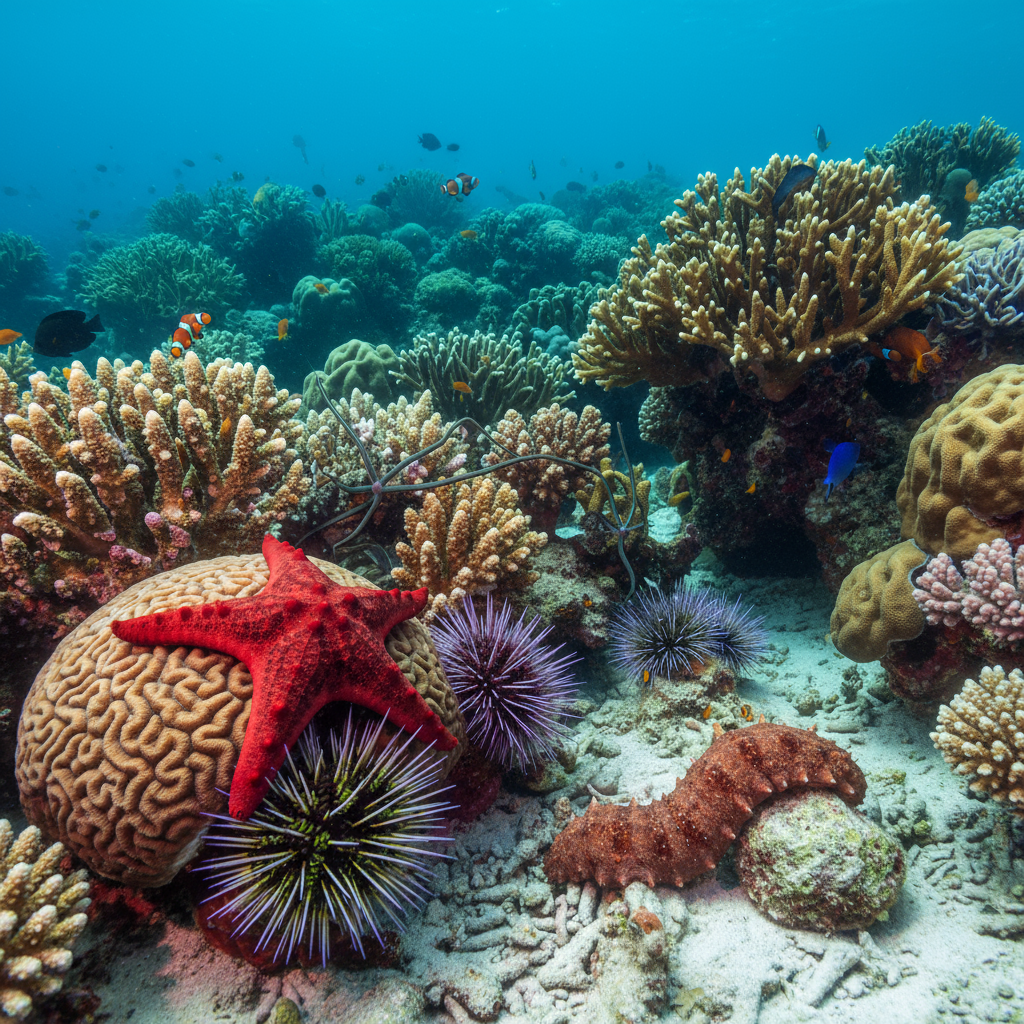Phylum Echinodermata: Characteristics, Classification, and Importance
Phylum Echinodermata is one of the most fascinating and unique groups in the animal kingdom. These exclusively marine animals exhibit remarkable features, including a water vascular system, radial symmetry in adults, and a calcareous endoskeleton. Echinoderms include familiar sea creatures like starfish, sea urchins, sand dollars, brittle stars, and sea cucumbers. Their evolutionary significance, ecological roles, and distinctive anatomical structures make them an essential subject in marine biology and zoology.
General Characteristics of Phylum Echinodermata
Echinoderms possess a combination of features that distinguish them from all other invertebrates. The following are some of their defining characteristics:
1. Habitat
Echinoderms are exclusively marine and are found in all oceans, from intertidal zones to the deep sea. They prefer benthic habitats, living on or near the ocean floor.
2. Body Symmetry
While echinoderm larvae exhibit bilateral symmetry, adult echinoderms display pentaradial symmetry—a five-part radial symmetry that is key to their structure and function.
3. Endoskeleton
The body of an echinoderm is supported by an internal skeleton made of calcium carbonate plates or ossicles. These ossicles often bear spines, giving rise to the name “echinoderm,” which means “spiny skin” in Greek.
4. Water Vascular System
This unique hydraulic system plays a crucial role in locomotion, feeding, respiration, and sensory reception. It consists of canals and tube feet, which function via water pressure and allow echinoderms to move and manipulate their environment.
5. Tube Feet
Connected to the water vascular system, tube feet extend through openings in the skeletal plates and help in movement, attachment to surfaces, and food handling.
6. No Head or Brain
Echinoderms lack a centralized brain. Instead, they have a nerve ring and radial nerves that coordinate movements and responses to stimuli.
7. Regeneration
One of the most remarkable abilities of echinoderms is regeneration. Many can regrow lost arms, and in some cases, entire new individuals can form from a single limb or body fragment.
Classification of Phylum Echinodermata

Phylum Echinodermata is divided into five main classes, each with distinctive features:
1. Class Asteroidea (Sea Stars or Starfish)
- Radially symmetrical with five or more arms.
- Mouth on the underside and anus on the upper side.
- Predators that feed on mollusks, using tube feet to pry open shells.
2. Class Ophiuroidea (Brittle Stars and Basket Stars)
- Slender, flexible arms distinct from the central disc.
- No anus; waste is expelled through the mouth.
- More agile and faster than other echinoderms.
3. Class Echinoidea (Sea Urchins and Sand Dollars)
- Globular or flattened body without arms.
- Covered with movable spines and tube feet.
- Have a unique chewing apparatus called Aristotle’s lantern.
4. Class Holothuroidea (Sea Cucumbers)
- Soft-bodied and elongated with leathery skin.
- Lack spines and rigid endoskeleton.
- Some species expel internal organs (evisceration) as a defense mechanism and later regenerate them.
5. Class Crinoidea (Feather Stars and Sea Lilies)
- Most primitive echinoderms.
- Sessile (attached) or free-swimming.
- Use feathery arms to filter feed.
Reproduction and Development
Echinoderms reproduce both sexually and asexually. Most species are dioecious (having separate sexes), though some are hermaphroditic. Fertilization is usually external. The resulting larvae are bilaterally symmetrical and undergo metamorphosis to develop into radially symmetrical adults.
Asexual reproduction occurs through fragmentation and regeneration, particularly in starfish and brittle stars. This mode of reproduction enhances their survival and helps maintain population density in various marine habitats.

Ecological and Economic Importance of Echinoderms
1. Role in Marine Ecosystems
Echinoderms play vital roles in maintaining ecological balance in marine ecosystems:
- Predation: Starfish help regulate populations of bivalves like mussels and clams.
- Bioturbation: Sea cucumbers and other echinoderms churn up sediment, aiding nutrient recycling.
- Food source: They are prey for various marine animals, including fish, birds, and humans.
2. Indicator Species
Due to their sensitivity to environmental changes, echinoderms serve as bioindicators of ocean health. Declines in their populations can signal issues like ocean acidification or pollution.
3. Biomedical Research
Echinodermata are important model organisms in developmental biology and regenerative medicine. Their ability to regenerate lost limbs provides insights into cellular repair and stem cell function.
4. Commercial Use
Some species, particularly sea cucumbers, are harvested as delicacies in many Asian cuisines. Sea urchin roe (uni) is also a prized ingredient in Japanese sushi.
Threats and Conservation
Echinodermata face multiple threats, including:
- Climate change: Rising ocean temperatures and acidification affect their calcified skeletons.
- Overfishing: Sea cucumbers and urchins are overexploited in many regions.
- Habitat destruction: Coral reef degradation and seabed trawling damage echinoderm habitats.
Conservation efforts include marine protected areas (MPAs), sustainable harvesting practices, and further research into their ecological roles.
Conclusion
Phylum Echinodermata represents a vital group of marine invertebrates that contribute significantly to ocean health, biodiversity, and human interests. Their unique biology, from radial symmetry to the water vascular system and regeneration abilities, makes them a subject of continuous scientific interest. With rising environmental concerns, understanding and conserving these organisms is more important than ever.
References
- National Geographic – Echinoderms
https://education.nationalgeographic.org/resource/echinoderm - Britannica – Echinoderm
https://www.britannica.com/animal/echinoderm - NOAA – Echinoderms Explained
https://oceanexplorer.noaa.gov/facts/echinoderms.html - Smithsonian Ocean – Sea Stars & Their Relatives
https://ocean.si.edu/ocean-life/invertebrates/sea-stars-and-their-relatives - UCMP Berkeley – Introduction to the Echinodermata
https://ucmp.berkeley.edu/echinoderm/echinoderm.html


Pingback: Antedon (Feather stars) | Zoologyverse | 2025
Pingback: Asterias (Sea Star or Starfish) | Zoologyverse | 2025
Pingback: Luidia | Zoologyverse | 2025
Pingback: Pentaceros: The Sea Pentagon (Starfish) | Zoologyverse | 2025
Pingback: Astropecten | Zoologyverse | 2025
Pingback: Ophioderma | Zoologyverse | 2025
Pingback: Ophiocoma | Zoologyverse | 2025
Pingback: Ophiothrix | Zoologyverse | 2025
Pingback: Clypeaster | Zoologyverse | 2025
Pingback: Strongylocentrotus | Zoologyverse | 2025